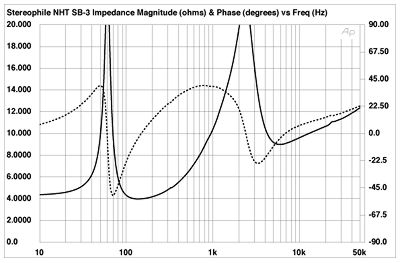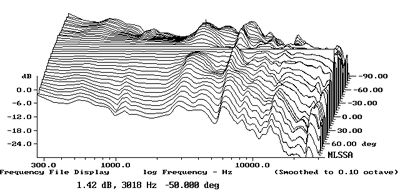| Columns Retired Columns & Blogs |
NHT SB-3 loudspeaker Measurements
Sidebar 3: Measurements
Footnote 1: The droop above 15kHz in the initial response in this graph, by the way, is due to the fact that I averaged 128 separate measurements to reduce the effect of environmental noise on this measurement. However, when there is a slight breeze—I measure speakers outdoors—the slight differences in path lengths that result from the air movement tend to cancel some of the highest-frequency energy when the measurements are averaged.—JA
I didn't find the NHT SB-3 to be as sensitive as the specification claims: my estimate of its B-weighted sensitivity was around the same as the similarly sized LS3/5A, at 82.5dB/2.83V/m. Fig.1 reveals that the speaker is easy to drive in the upper midrange and above, where its impedance remains above 8 ohms. However, in the lower midrange the impedance drops to 4 ohms, with a somewhat demanding combination of 42 degrees capacitive phase angle and 5.7 ohms magnitude evident at 81Hz.

Fig.1 NHT SB-3, electrical impedance (solid) and phase (dashed). (2 ohms/vertical div.)
The fig.1 traces are free from the wrinkles and discontinuities that would hint at the presence of cabinet panel resonances. While a vibrational mode at 332Hz could be detected on all surfaces (fig.2), it is low enough in level, and the cabinet surfaces are of sufficiently limited surface area, that I doubt this mode will have any subjective consequences.

Fig.2 NHT SB-3, cumulative spectral-decay plot calculated from the output of an accelerometer fastened to the cabinet's side panel. (MLS driving voltage to speaker, 7.55V; measurement bandwidth, 2kHz.)
The single impedance peak at 60Hz in fig.1 indicates the tuning frequency of the sealed enclosure, which is confirmed by fig.3. The woofer's response peaks between 200Hz and 55Hz before rolling off at 12dB/octave. This upper-bass peak will be partly due to the nearfield measurement technique, but it does appear that the SB-3's designer has gone for a lightly underdamped woofer alignment, which, in combination with the relatively slow rolloff below resonance, will give the impression that the speaker has more bass than it really does.

Fig.3 NHT SB-3, anechoic response on listening axis at 50" with grille on, averaged across 30 degrees horizontal window and corrected for microphone response, with the nearfield woofer response plotted below 300Hz.
The nearfield woofer response, shown to the left of fig.3, is spliced to the NHT's farfield response, averaged across a 30 degrees horizontal window centered on the woofer axis. Overall, the balance is neutral, with peaks being balanced by dips. However, I was a bit perturbed by the peak apparent in the octave between 600Hz and 1kHz. This will tend to throw midrange detail forward a little in the soundstage, as well as make the speaker a little intolerant of high-level voices. Moving higher in frequency, the ultrasonic peak at 22kHz is lower in height than we usually see with metal-dome tweeters, while the region covered by the tweeter is reasonably flat.
All the measurements were taken with the SB-3's grille in place, as recommended by the speaker's designer. Fig.4 shows the effect of removing the grille on the NHT's on-axis response. The 1.5dB peak at 3kHz actually fills in one of the suckouts in fig.3, making the measured low-treble response flatter in the presence region. However, removing the grille results in considerably more energy in the octaves between 5kHz and 10kHz and between 15kHz and 30kHz. As BJR noted, removing the grille will make some instruments' upper harmonics sound exaggerated.

Fig.4 NHT SB-3, effect on anechoic response of removing the grille (1dB/vertical div.).
Figs. 5 and 6 show the NHT's lateral dispersion, the latter having the off-axis response curves normalized to the on-axis response. The peak at 800Hz is persistent, which, all things being equal, might be expected to add a slight nasality to the SB-3's balance. As BJR noted no upper-midrange coloration, this peak is perhaps low enough in level that it slips by unobserved, other than its effect on the perception of recorded detail. The suckouts at 3kHz and 6kHz in fig.3 actually fill in to the speaker's sides, suggesting that they are diffraction effects specific to the on-axis response. In a typically sized room, the SB-3's mid-treble will be perceived as neutrally balanced. However, the tweeter becomes quite directional above 10kHz, which will make the speaker sound a little lifeless in large rooms.

Fig.5 NHT SB-3, lateral response family at 50", from back to front: responses 90 degrees-5 degrees off-axis, on-axis response, responses 5 degrees-90 degrees off-axis.

Fig.6 NHT SB-3, lateral response family at 50", normalized to response on listening axis, from back to front: differences in response 90 degrees-5 degrees off-axis, reference response, differences in response 5 degrees-90 degrees off-axis.
In the vertical plane (fig.7), a big suckout develops in the crossover region for listeners more than 15 degrees above and 5 degrees below the woofer axis. This suggests that low stands will be better than high ones.

Fig.7 NHT SB-3, vertical response family at 50", normalized to response on listening axis, from back to front: differences in response 45 degrees-5 degrees above axis, reference response, differences in response 5 degrees-45 degrees below axis.
The SB-3's step response (fig.8) confirms that both drive-units are connected with positive acoustic polarity, with the tweeter's step smoothly handing over to the woofer's. The undulations apparent in the latter are associated with the 800Hz peak, as can be seen in the cumulative spectral-decay plot (fig.9). There is also a ridge of delayed energy apparent in this graph at 5kHz, which might add a little steeliness to the NHT's presentation at high levels. This behavior might also correlate with Bob Reina's finding the SB-3's treble to sound slightly "crisp," though the decay in the rest of the treble is otherwise fairly clean (footnote 1).

Fig.8 NHT SB-3, on-axis step response at 50" (5ms time window, 30kHz bandwidth).

Fig.9 NHT SB-3, cumulative spectral-decay plot at 50" (0.15ms risetime).
Overall, this is quite good measured performance, though I was bothered by the existence of the 800Hz peak.—John Atkinson
Footnote 1: The droop above 15kHz in the initial response in this graph, by the way, is due to the fact that I averaged 128 separate measurements to reduce the effect of environmental noise on this measurement. However, when there is a slight breeze—I measure speakers outdoors—the slight differences in path lengths that result from the air movement tend to cancel some of the highest-frequency energy when the measurements are averaged.—JA
- Log in or register to post comments




































